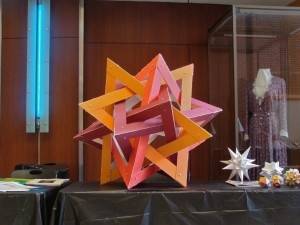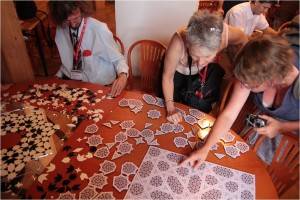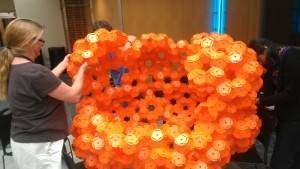If you asked a typical grade school student to describe math, they probably wouldn’t use the words creative or fun. The mathematics department at the U of I is hoping to change this by showing students there is more to math than memorizing equations. The University of Illinois will be hosting a MoSAIC Math + Arts Festival on November 21st and 22nd. MoSAIC stands for Mathematics of Science, Art, Industry, and Culture. Illinois is in good company as Berkeley and Columbia have already hosted similar festivals this fall. According to Assistant Professor of Mathematics and Director of the Illinois Geometry Lab Jayadev Athreya, they are expecting over five hundred students to come through the festival over the course of the two days. The free festival goes from 10 a.m.-5 p.m. each day and includes a variety of events. Athreya says you could be there all day and not do the same thing twice. I sat down with Athreya to discuss the festival.
SP: How did you get involved with the MoSAIC Festival?
Athreya: The University of Illinois is an institutional partner with a group called the Mathematical Sciences Research Institute (MSRI) out in Berkeley and we are one of the sponsors of MoSAIC. Our chairman Matthew Ando was visiting MSRI last fall, and he came into contact with a couple of the organizers of MoSAIC. They suggested that Illinois would be an interesting place to host an event. How the process works is you have to apply to host it. So we applied, it is a relatively simply thing. Then we were selected. That’s the bare bones of the story. The reason we thought Illinois would be a good fit is we have a great tradition of combining visualization and mathematics. It is something Illinois has pioneered. We’ve been pioneers in the virtual reality in mathematics segment and in general the borderline between math and art, we’ve been pioneers in that. We thought it’d be a natural fit to bring this art exhibit to our campus that focuses on mathematical aspects of art.

SP: Is the art department involved?
Athreya: We’ve definitely been in touch with them, and we have worked with them before but not on this project. One of the other organizers is Steve Taylor from the Department of Music.
SP: Is it mostly local students?
Athreya: We have a lot of students coming in from the Champaign area. The other reason we thought this would work really well is as a department we are one of the most involved mathematics departments in terms of public engagement and outreach. We are one of the top 20 research departments in the country, but kind of unique amongst those is we also have a really good public engagement profile. So we are in schools trying to share the creative aspects of mathematics. The whole point is math is a creative enterprise and we want to share that mission. We have a lot of contacts that we are relying on. Throughout the year we go out, we have workshops, we have kids come in on field trips. We also have a bus of kids coming down from Chicago on Saturday that we have worked with before. It’s an organization called Chi-prep. It’s Chicago public school kids who are every weekend doing science-related activities with their parents.
SP: What is the goal of the festival?
Athreya: It’s to engage with math in a creative fashion. It’s to activate centers of their brain they wouldn’t usually associate with mathematics. It’s all about working with your hands, working with physical manipulatives and connecting that to mathematical concepts. Basically activating the artistic and special sides of your brain when you’re thinking about mathematics. Which is something research mathematicians do all the time, our work is fundamentally creative. So many kids when they see math think about equations on a piece of paper that have been around for thousands of years and are just true, there is no creative part to it. But the point is, we are always creating and recognizing new patterns. That’s the point of the exhibit, to get kids to engage with math in a new and different way.
 SP: It says the festival is for 6th-12th graders which is a pretty wide range. How do you plan on accommodating all groups?
SP: It says the festival is for 6th-12th graders which is a pretty wide range. How do you plan on accommodating all groups?
Athreya: When you are trying to engage people creatively, it often doesn’t matter what age they are. This is going to be so far outside the traditional curriculum. It’s going to be engaging them creatively in a way that it doesn’t matter how old the kid is. There will be something to grab on to. We are encouraging younger kids to come by as well. Children of all ages from 5 to 100 will enjoy this event.
 SP: Are you hoping the festival promotes the Illinois math department?
SP: Are you hoping the festival promotes the Illinois math department?
Athreya: Absolutely. We are really hoping to get more people in here. Altgeld Hall is a building that everybody in town knows. Very few people have an idea of what goes on in here. They think “oh that’s where I took my calc class”. What we want to show is this is a place where incredibly creative and exciting and innovative things are happening. Cutting edge research as well as cutting edge public engagement is happening. The idea is to get the word out about the events we are doing.
Photos are of previous festivals found on the MoSAIC website used with persmission.








